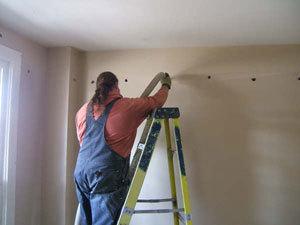Mike Holmes is one of Canada’s most respected contractors and TV personalities. He is known for the slogan “Make it right.” I am a fan of his; he knows renovations and describes his approach well in his book. However, he is not a soundproofing contractor, yet, he promotes soundproofing myths.
More...
Soundproofing myths.
However, his knowledge of soundproofing has many gaps. He is not a soundproofing contractor, nor he claims to be one. He has several articles and YouTube videos where he dispenses soundproofing advice. In his recent article in the National Post, he propagates no less than six soundproofing myths circulating on the Internet. Many so-called soundproofing contractors pick up similar tales.
The sentences in quotes are almost verbatim from the noted article.
Soundproofing myth #1:
Fact: Adding a reasonable amount of sound absorption in a typical residential room only affects the noise level in that room. Hardly worth the effort, as documented in reference [1].
Myth #2:
Fact: This is incorrect because there are gaps between the wall and the furniture. These gaps, and the fact that you cannot cover the whole wall, negates the effect of noise reduction [2]. The only exception is built-in furniture covering the entire wall that is sealed against the wall. Then the noise reduction can be noticeable to significant, depending on how the furniture is constructed.
Soundproofing Myth #3:
“Carpets can reduce noise from downstairs neighbours”.
Fact: The only way that sound attenuation of a floor can be increased is by adding mass to the floor that significantly increases (doubles or more) the mass of the existing floor [2]. Carpet and underlayment certainly cannot do it in most situations.
Myth #4:
“Insulation in walls helps a lot”.
Fact: This is the most common misconception that many a soundproofing contractor promotes. Adding insulation to an existing hollow wall reduces sound only a little. For example, if you add insulation to a standard wall with 3.5” wood studs and 5/8” drywall on each side, the STC value is increased from STC 32 to STC 36 [3], a modest improvement, insufficient in most situations.
Soundproofing myth #5:
“Sound reducing drywall is as good as 8 layers of regular drywall”.
Fact: This is a widely circulated myth, probably originated by a manufacturer of sound-reducing drywall. It is meaningless to evaluate a noise reduction of a sheet of drywall, any drywall because it is only used in assemblies.
For example, you enhanced the sound attenuation of an existing wall consisting of 3.5” steel studs on 24” centers and insulation in cavities. If you replace a standard drywall on one side of this wall with a sound-reducing drywall, the STC value will increase from STC 38 [2] to STC 52 [4]. The same wall, but with two layers of standard drywall on each side, provides STC 54 [5]. You get better results by adding new drywall sheets on each side than by replacing one sheet with sound-reducing drywall. Where is the myth of 8 sheets coming from? If you know, submit the feedback form at the end of this article.
Myth #6:
“Adding blown-in cellulose insulation into walls adds a lot of echo-dampening power”.
Fact: I am not sure what “echo dampening power” means, but I do not recommend blowing insulation into existing walls. Many so-called soundproofing contractors recommend it. As explained previously, the effect of insulation in wall cavities is only modest if the wall is filled perfectly. Perfect fill cannot be guaranteed by blowing insulation into cavities.
In conclusion, you must rely on something other than soundproofing advice from a respected celebrity contractor. It would be best if you did not rely on the advice of a so-called soundproofing contractor either. A poorly implemented soundproofing project is costly. The soundproofing contractor does not pay for it; he makes his profit. The customer must live with noise after paying for soundproofing or reworking the soundproofing job, doubling the project's cost. I have many clients with this unfortunate experience; an example is described in this article.
Good soundproofing advice by a professional building acoustics engineer is not expensive; it should be a part of each well-done soundproofing project. You will find more information about what a soundproofing consultant does in this article. To request a quote from the author, submit the button below.
References
[1] Sound absorption
[2] Master Handbook of Acoustics
[3] National Building Code of Canada
[4] QuietRock gypsum boards
[5] National Gypsum
I always appreciate a reader's comments. If you have a comment, suggestion or a critique, please submit the form below. Your email address and message are completely private, accessible only by me.
